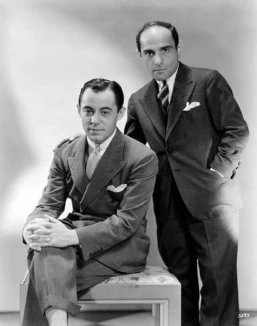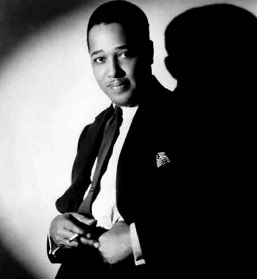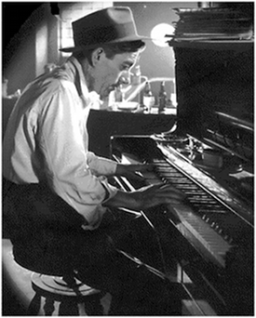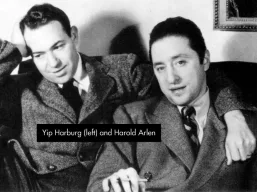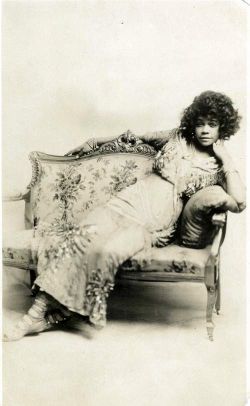George and Ira Gershwin: selected songs, 1919 to 1927
__________________________________
- page originally published on 19 March 2009; latest edit: 25 July 2022
- See also our George and Ira Gershwin feature page index.
__________________________________
George Gershwin (September 26, 1898 – July 11, 1937)
From George Gershwin Remembered: About the Composer, PBS American Masters series, dated June 7, 2006 (images added):
 George Gershwin was born in Brooklyn in 1898, the second of four children from a close-knit immigrant family. He began his musical career as a song-plugger on Tin Pan Alley, but was soon writing his own pieces. Gershwin’s first published song, When You Want ‘Em, You Can’t Get ‘Em, demonstrated innovative new techniques, but only earned him five dollars. Soon after, however, he met a young lyricist named Irving Ceaser. Together they composed a number of songs including Swanee, which sold more than a million copies.
George Gershwin was born in Brooklyn in 1898, the second of four children from a close-knit immigrant family. He began his musical career as a song-plugger on Tin Pan Alley, but was soon writing his own pieces. Gershwin’s first published song, When You Want ‘Em, You Can’t Get ‘Em, demonstrated innovative new techniques, but only earned him five dollars. Soon after, however, he met a young lyricist named Irving Ceaser. Together they composed a number of songs including Swanee, which sold more than a million copies.
In the same year as Swanee, Gershwin collaborated with Arthur L. Jackson and Buddy De Sylva on his first complete Broadway musical, La, La Lucille.  Over the course of the next four years, Gershwin wrote forty-five songs; among them were Somebody Loves Me and Stairway to Paradise, as well as a twenty-five-minute opera, Blue Monday. Composed in five days, the piece contained many musical clichés, but it also offered hints of developments to come.
Over the course of the next four years, Gershwin wrote forty-five songs; among them were Somebody Loves Me and Stairway to Paradise, as well as a twenty-five-minute opera, Blue Monday. Composed in five days, the piece contained many musical clichés, but it also offered hints of developments to come.
 In 1924, George collaborated with his brother, lyricist Ira Gershwin, on a musical comedy “Lady Be Good”. It included such standards as “Fascinating Rhythm” and “The Man I Love.” It was the beginning of a partnership that would continue for the rest of the composer’s life. Together they wrote many more successful musicals including “Oh Kay!” and “Funny Face”, staring Fred Astaire and his sister Adele. While continuing to compose popular music for the stage, Gershwin began to lead a double life, trying to make his mark as a serious composer.
In 1924, George collaborated with his brother, lyricist Ira Gershwin, on a musical comedy “Lady Be Good”. It included such standards as “Fascinating Rhythm” and “The Man I Love.” It was the beginning of a partnership that would continue for the rest of the composer’s life. Together they wrote many more successful musicals including “Oh Kay!” and “Funny Face”, staring Fred Astaire and his sister Adele. While continuing to compose popular music for the stage, Gershwin began to lead a double life, trying to make his mark as a serious composer.
When he was 25 years old, his jazz-influenced Rhapsody in Blue premiered in New York’s Aeolian Hall at the concert, An Experiment in Music. The audience included Jascha Heifitz, Fritz Kreisler, Leopold Stokowski, Serge Rachmaninov, and Igor Stravinsky. Gershwin followed this success with his orchestral work Piano Concerto in F, Rhapsody No. 2 and An American in Paris. Serious music critics were often at a loss as to where to place Gershwin’s classical music in the standard repertoire. Some dismissed his work as banal and tiresome, but it always found favor with the general public.
Gershwin’s classical music in the standard repertoire. Some dismissed his work as banal and tiresome, but it always found favor with the general public.
In the early thirties, Gershwin experimented with some new ideas in Broadway musicals. Strike Up The Band, Let ‘Em Eat Cake, and Of Thee I Sing, were innovative works dealing with social issues of the time. Of Thee I Sing was a major hit and the first comedy ever to win the Pulitzer Prize. In 1935 he presented a folk opera Porgy and Bess in Boston with only moderate success. Now recognized as one of the seminal works of American opera, it included future standards such as It Ain’t Necessarily So; I Loves You, Porgy; and Summertime.
In 1937, after many successes on Broadway, the brothers decided go to Hollywood. Again they teamed up with Fred Astaire, who was now paired with Ginger Rogers. They made the musical film, Shall We Dance, which included such hits as Let’s Call the Whole Thing Off and They Can’t Take That Away From Me. Soon after came A Damsel in Distress, in which Astaire appeared with Joan Fontaine. After becoming ill while working on a film, he had plans to return to New York to work on writing serious music. He planned a string quartet, a ballet and another opera, but these pieces were never written. At the age of 38, he died of a brain tumor. Today he remains one of America’s most beloved popular musicians.
the brothers decided go to Hollywood. Again they teamed up with Fred Astaire, who was now paired with Ginger Rogers. They made the musical film, Shall We Dance, which included such hits as Let’s Call the Whole Thing Off and They Can’t Take That Away From Me. Soon after came A Damsel in Distress, in which Astaire appeared with Joan Fontaine. After becoming ill while working on a film, he had plans to return to New York to work on writing serious music. He planned a string quartet, a ballet and another opera, but these pieces were never written. At the age of 38, he died of a brain tumor. Today he remains one of America’s most beloved popular musicians.
____________________
Rialto Ripples (George Gershwin, Will Donaldson) — Gershwin had his first commercial success with this novelty rag in 1917, at age 18.
Regina music box
.
UniRecord 202935 piano roll, played by George Gershwin – 1917
The provider says:
George Gershwin’s own piano roll of Rialto Ripples (UniRecord 202935, 1917). Recorded at the Old Rectory, Landbeach by Julian Dyer, 25 Sept 2010. Played using an 88-note Pianola pushup on a Bechstein grand.
_________________
Selected songs, 1919-1927:
- 1919 – Swanee
- 1924 – Oh, Lady Be Good; Fascinating Rhythm; The Man I Love
- 1926 – Someone to Watch Over Me
- 1927 – Strike Up the Band
1919
Swanee (m. George Gershwin, w. Irving Caesar)
from Wikipedia (image added):
“Swanee” is an American popular song written in 1919 by George Gershwin, with lyrics by Irving Caesar. It is most often associated with singer Al Jolson.
The song was written for a New York City revue called Demi-Tasse, which opened in October 1919 in the Capitol Theater. Caesar and Gershwin, who was then aged 20, claimed to have written the song in about ten minutes riding on a bus in Manhattan, finishing it at Gershwin’s apartment. It was written partly as a parody of Stephen Foster‘s “Old Folks at Home“. It was originally used as a big production number, with 60 chorus girls dancing with electric lights in their slippers on an otherwise darkened stage.[1]
The song had little impact in its first show, but not long afterwards Gershwin played it at a party where Al Jolson heard it. Jolson then put it into his show Sinbad, already a success at the Winter Garden Theatre, and recorded it for Columbia Records in January 1920.[2] “After that”, said Gershwin, “Swanee penetrated the four corners of the earth.” The song was charted in 1920 for 18 weeks holding the No. 1 position for nine.[3] It sold a million sheet music copies, and an estimated two million records.[4] It became Gershwin’s first hit and the biggest-selling song of his career; the money he earned from it allowed him to concentrate on theatre work and films rather than writing further single pop hits. Arthur Schwartz said: “It’s ironic that he never again wrote a number equaling the sales of Swanee, which for all its infectiousness, doesn’t match the individuality and subtlety of his later works.”[5]
_____________________________
piano rolls
U.S. Music Co. “Word Roll” 39835, played by Mae Brown and Chet Gordon – 1919
.
Duo-Art, Nº 1649, played by George Gershwin – 1920
.
.
Rhythmodik label Z105603, played by Herbert Clair & Muriel Pollock – 1920
.
Ampico, played by Clair & Pollock — It’s not clear to me if this is a copy of the Rhythmodik label roll above, or vice versa.
_____________________
Al Jolson – According to the Discography of American Historical Recordings, three takes recorded by Jolson on 8 January 1920 were mastered and given the matrix number 78917. Of these, at least two were issued on versions of the 78 rpm single Columbia A2884, c/w “My Gal” (flip side recorded by Frank Crumit). 45Worlds.com indicates that Columbia A2884 was released in April 1920, with “Swanee” the A-side and “My Gal” the B-side.
.
audio file, Ogg Vorbis (1.1 MB), from the page Collected Works of Al Jolson, at archive.org:
.
Sanford’s Famous Dance Orchestra — recorded in March 1920; issued on Emerson 10185, c/w “On Miami Shore”
audio file, VBR MP3 (4.8 MB), from the page SWANEE (uploaded by @jakej), at archive.org:
.
Peerless Quartet — recorded on 9 June 1920 (Victor matrix # B-24159) in Camden, New Jersey; issued in October 1920 on the 78 rpm single Victor 18688, as the B-side of “Dardanella” (A-side by Billy Murray and Ed Smalle)
.
Van Eps Quartet — recording date unidentified; issued in 1920, as “Swanee–One-Step,” on (Canada) His Master’s Voice 216090, b/w (according to doc evans) “I Might Be your Once In Awhile”
The site Southern Percussion says:
The piece was recorded in an instrumental version (HMV Canada #216090) by the Van Eps Quartet with Gershwin himself on piano, Fred Van Eps on banjo, Nathan Glantz on tenor saxophone, and George Hamilton Green on xylophone.
_______________________________
The following songs have music by George Gershwin and words by Ira Gershwin unless otherwise noted.
1924
In 1924, the same year that Rhapsody in Blue was composed, George and Ira Gershwin were engaged to write the musical score for the Broadway show Lady, Be Good, their first collaboration. The play, written by Guy Bolton, Fred Thompson, debuted at the Liberty Theatre on December 1, 1924.
George and Ira Gershwin were engaged to write the musical score for the Broadway show Lady, Be Good, their first collaboration. The musical, with book by Guy Bolton and Fred Thompson, debuted at the Liberty Theatre on December 1, 1924. The jazz standards Oh, Lady Be Good! and Fascinating Rhythm were introduced in this show. A third, The Man I Love, was dropped, as explained below.
Oh, Lady Be Good
Paul Whiteman and his Orchestra — recorded on 29 December 1924; issued 6 February 1925 the 78 rpm single (US) Victor 19551, as the B-side of “Fascinating Rhythm”
.
Carl Fenton and his Orchestra – recorded 11 December 1924
.
Percival Mackey’s Band
1. as “The “1926” Orchestra” — issued in 1926 on (UK) Columbia 9100 — Each side of the disc contains a medley of songs from the musical Lady, Be Good. The side 1 medley, titled “Lady Be Good, selection — Part 1,” features Oh, Lady be good / Hang on to me / I’d rather Charleston.
.
2. Percival Mackey’s Band, vocal: Monty Woolf – issued on (UK) Columbia 3941
.
Count Basie & his Orchestra, featuring Lester Young – recorded 9 October 1936
.
Eleanor Powell and her dog in the film Lady Be Good – 1941
.
Jazz at the Philharmonic — “Philharmonic Auditorium”, Los Angeles, CA, 28 January 1946
Al Killan, Howard McGhee (tp) Charlie Parker, Willie Smith (as) Lester Young (ts) Arnold Ross (p) Billy Hadnott (b) Lee Young (d)
.
Cleo Laine and the Johnny Dankworth Band in an episode of the BBC series Jazz 625, dated February 1965
Pages: 1 2















